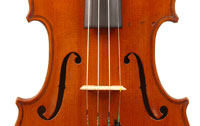|
Ref : 0842
A very good English violin by
|

go to Home Page see more Violins |
This violin was recently discovered in a state of oblivion after spending some 40 years in storage. It fortunately had been kept in a very safe environment without strings or soundpost, hence it is today in virtually mint condition - probably one of the finest examples of Emanuel Whitmarsh's work toward the end of his career.Whitmarsh's dates of birth and death are not noted in any reliable source, but since he was already working in London in 1856 , it is thought that he was probably born around 1840. He established his studio in Kentish Town Road in 1885 and later moved to Dalston (London), in 1908. He was awarded a medal at the Inventions Exhibition in London in 1885. It is known that he was still active at the end of the First World War in 1918, and would then have been around 78 years old.
Emanuel Whitmarsh's instruments are much desired and actively sought after by professional musicians everywhere, not only because of there superb workmanship, but notably for their tone, which has variously been described as strong, clear, focussed and extremely well-balanced over the full register. Those who own a Whitmarsh will simply not part with them and have very high appreciation for their instruments' tonal properties.
This maker consistently labelled his instruments with a simple hand-written label, making them easy to identify positively through the handwriting. Furthermore, he was consistent in his instrument design through most of his life and his violins have somewhat of a characteristic appearance, particularly in the f-hole shape, somewhat long and slanting out to the bottom curve, yet elegant and balanced. This violin is dated 1912, in London.
This instrument has a beautiful one-piece back of the most superb maple, mildly flamed with a straight even medium curl. The ribs appear to be of the same wood, but the neck and scroll are of more finely figured wood. The top is of a piece of excellent tone spruce with medium to fine growth lines. The scroll is really beautiful - balanced and noble. Purfling and cornerwork show an experienced and steady hand - really tidy work.
The varnish deserves special mention - it is a light golden brown with unusually high degree of transparency, allowing the light to interact with the wood throughout. This is the work of a master where everything is honed to essentials, refusing to give way to cheap visual embellishment. This violin's visual appeal lies in appreciation for the attention to detail where nothing is superfluous to the whole.
As with all violins by this maker, this is a very well-toned instrument, balanced, clean and focussed sound in which everything works just right.
 |
 |
 |
||
 |
Dimensions : Length of back: 35.5 cm
Condition : Excellent condition. A scratch in the top next to the fingerboard, treble side, is merely superficial. There is a minor 2 cm crack in the lower bass rib, near the chinrest area. This is probably the result of an impact, but it is virtually invisible and poses no threat to the violin's structural integrity.
Provenance : Earlier provenance unknown. Owned by Johan Grobbelaar.
Price : P.O.A.
 |
 |
 |
 |
 |
 |
 |
 |
 |
 |
 |
 |
|||||
 |
 |
 |
 |